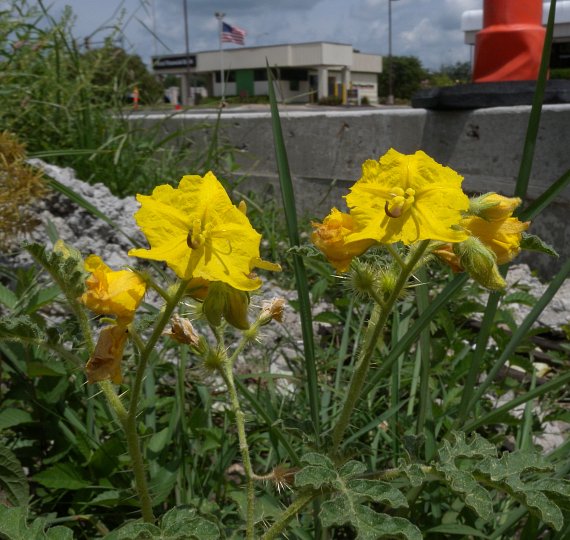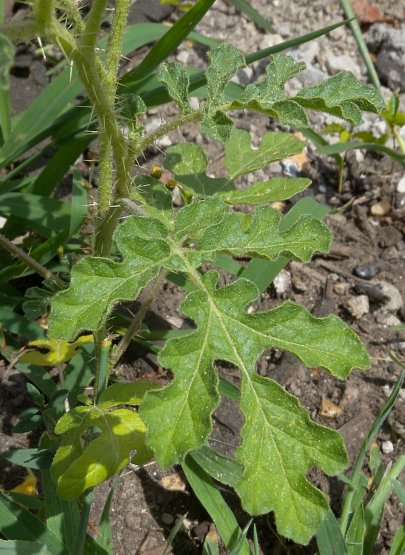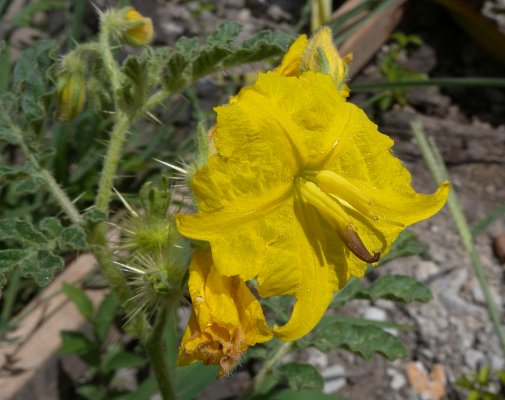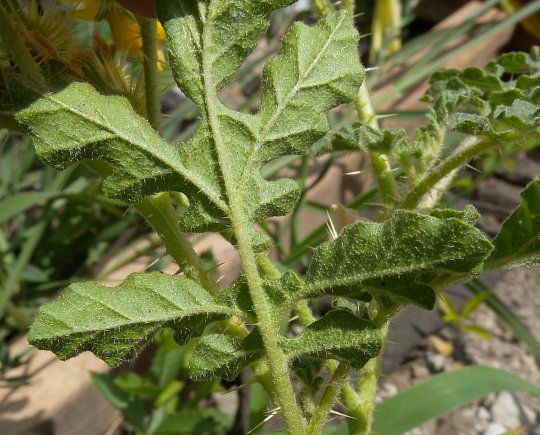
The petioles are ½-3" long, mostly pale green, and stellate-pubescent; their upper sides are flat to slightly concave, while their lower sides are convex. The lower sides of the petioles also have spines that resemble those along the stems. Sometimes the lower petioles become pale reddish purple with age. The upper stems terminate in short racemes of flowers. There are about 3-10 flowers per raceme, although some flowers may abort. Each flower is about 1" (2.5 cm.) across, consisting of yellow corolla with 5 ovate-triangular lobes, a short-tubular green calyx with 5 linear-lanceolate teeth, 5 stamens, and a pistil with a single style. Both the body and lobes of the calyx are stellate-pubescent; the body of the calyx, which encloses the ovary, is also densely covered with spines that resemble those of the stems and other parts of this plant. The stamens are dimorphic: 4 upper stamens (organized as 2 pairs) are yellow, straight, and smaller in size than the lower stamen, which is more orange-red (particularly toward its tip) and slightly curved. The pedicels of the flowers are up to ½" (12 mm.) long.

The blooming period occurs from early summer to early fall, lasting 1½-3 months. In the absence of cross-pollination, the flowers are self-fertile. After the blooming period, each raceme elongates to as much as 3" in length, often curving laterally. As the berries develop, the spiny calyces enclosing them expand in size and become more or less globoid. These berries are semi-dry and inedible; each berry contains several seeds. Eventually, the plant breaks off near the base of it central stem, when it becomes a tumbleweed that can be blown about by the wind, scattering its seeds along the way. Individual seeds are 2.0-2.5 mm. long, dark brown or black, and chunky. The root system consists of a branching taproot that can run deep into the ground. This plant reproduces only by reseeding itself.

Cultivation: The preference is full sun, mesic to dry conditions, and open soil containing loam, clay, or stony material. Alkaline soil is readily tolerated. Hot summer weather is preferred. Seeds require exposure to cold temperatures (winter dormancy) before they will germinate; they can remain viable in the ground for up to 10 years.
Range & Habitat: The non-native Buffalo-Bur is occasional in central and northern Illinois, while in the southern section of the state it is uncommon or absent (see Distribution Map). It is adventive from areas further to the west in the United States and Mexico. This plant has also spread to Eurasia, Australia, and South Africa, where it is regarded as a troublesome weed in many areas. Habitats consist of dry upland prairies, fields, pastures, roadsides, areas along railroads, construction sites, and waste areas. This weedy plant is typically found in open disturbed areas where the ground surface has been exposed and there is reduced competition from other ground vegetation.

Faunal Associations: The flowers are cross-pollinated by medium- to large-sized bees, including bumblebees. The floral reward of such visitors is pollen. Several species from the leaf beetle family (Chrysomelidae) feed on the foliage of Buffalo-Bur and other Solanum spp. These species include Epitrix cucumeris (Potato Flea Beetle), Epitrix fuscula (Eggplant Flea Beetle), Epitrix hirtipennis (Tobacco Flea Beetle), Lema trivittata (Three-Lined Potato Beetle), and Leptinotarsa decemlineata (Colorado Potato Beetle). Buffalo-Bur is one the original host plants of the Colorado Potato Beetle, which expanded its range eastward after the potato (Solanum tuberosum) became widely cultivated. The polyphagous Aphis rumicis (Dock Aphid) also sucks plant juices from many Solanum spp. The foliage of Buffalo-Bur contains alkaloids that are toxic to mammalian herbivores, and its spines can injure the gastrointestinal tracts and mouthparts of such animals. Therefore, they usually avoid browsing on this plant, although it is sometimes found in the fodder (e.g., hay) that is fed to such animals. The spiny fruits of Buffalo-Bur can cling to the woolly hairs of buffalo and domestic sheep. As a result, these animals can spread the seeds to new areas.

Photographic Location: A construction site in Urbana, Illinois.
Comments: Among the Solanum spp. in Illinois, Bur-Bur can be distinguished by its large yellow flowers (about 1" or 2.5 cm. across), bluntly lobed leaves, spiny foliage, and spiny fruits. Because this western plant prefers areas with a dry climate and relatively barren soil, it is not invasive in Illinois to any significant extent, however occasionally scattered plants of this species are encountered. A more common species within the state, Solanum carolinense (Horse Nettle), also has spiny foliage, but its flowers are either white or pale purple and its fruits are yellow berries without spines. There are other western Solanum spp. in Illinois that are rarely encountered, but they lack the yellow flowers of Buffalo-Bur and differ from it in other characteristics. Sometimes Buffalo-Bur has been referred to as Solanum cornutum, but apparently this is the scientific name of another plant species.